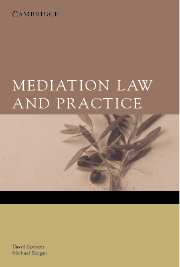Book contents
- Frontmatter
- Contents
- Acknowledgements
- Preface
- List of tables and figures
- Table of statutes
- Table of cases
- PART I THE PRACTICE OF MEDIATION
- 1 Mediation: Its Definition and History
- 2 The Mediation Process
- 3 The Theory and Philosophy of Mediation
- 4 Specific Types of Mediation
- 5 The Mediator
- 6 The Ethics of Mediation
- 7 Power, Empowerment and Difference in Mediation
- PART II THE LAW OF MEDIATION
- Bibliography
- Index
7 - Power, Empowerment and Difference in Mediation
Published online by Cambridge University Press: 05 June 2012
- Frontmatter
- Contents
- Acknowledgements
- Preface
- List of tables and figures
- Table of statutes
- Table of cases
- PART I THE PRACTICE OF MEDIATION
- 1 Mediation: Its Definition and History
- 2 The Mediation Process
- 3 The Theory and Philosophy of Mediation
- 4 Specific Types of Mediation
- 5 The Mediator
- 6 The Ethics of Mediation
- 7 Power, Empowerment and Difference in Mediation
- PART II THE LAW OF MEDIATION
- Bibliography
- Index
Summary
Introduction
In this chapter we examine the important issue of power in mediation. One of the philosophical tenets of mediation is that it empowers its users: see Chapter 3. However, mediation may not necessarily repair power imbalances brought about by gender or culture, or by the presence of the mediator him or herself. We begin by examining the concept of power in mediation generally. In this respect we highlight the nature of the power issues in mediation, the difficulties confronting mediators in maintaining neutrality in the face of power imbalances, and strategies to address power imbalances. From there we examine two well-researched areas of power ‘problems’: gender and cultural differences.
Power in mediation
In Chapter 3 we addressed the fact that power imbalances may lead to mediation not being the most appropriate means of dispute settlement. In this first section we examine power more generically. In the first extract Claire Baylis, Senior Lecturer in Law, Victoria University, Wellington, and Robyn Carroll, Senior Lecturer in Law, The University of Western Australia, provide a detailed introduction to power in mediation (Baylis & Carroll 2002, pp 287–96). Based on the seminal work of Bernie Mayer (1987), they begin with an explanation of the nature of power in dispute resolution, by way of multiple examples, and then turn to issues of legitimacy in mediation. In so doing Baylis and Carroll revisit the thesis of Hilary Astor (2000 (I); 2000 (II)) on neutrality that we also noted in Chapter 3.
- Type
- Chapter
- Information
- Mediation Law and Practice , pp. 223 - 262Publisher: Cambridge University PressPrint publication year: 2007



